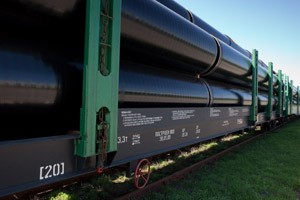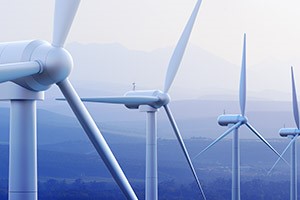Large-diameter pipes (LDP) have a diameter of 480-2,500 mm (or larger) and are used to construct main pipelines to transport oil and gas over long distances, as well as to construct other process pipelines, heat supply networks, water lines and sewerage facilities. Thick-gauge pipe steel is used to manufacture longitudinal-welded large-diameter pipes.
Offshore structures are marine facilities used to extract and store oil and gas, and to generate and accumulate electricity produced by renewable energy sources like wind, water or solar. This industry mainly uses steel plates to manufacture load-bearing structures, deep-water platforms, and wind, wave and solar power stations.
For onshore alternative energy, steel plates are mainly used for wind towers.




Application


Downloads
-
Catalogue
-
Plateslearn more
-
Product range and properties of steel plates for large-diameter pipes, offshore structures and energy application
Flat steel is used to produce longitudinally welded (single seam or double seam) large-diameter pipes. The key requirements for such steel include weldability, high strength and impact toughness (also at freezing temperatures), corrosion resistance, guaranteed strength through plate thickness (Z test), and others. The larger the diameter of single-seam line pipes, the more essential it is to ensure the rolled steel width up to 4,800 mm. In the future, more extensive use of X80-Х100 steel grades instead of Х60-X70 for high-pressure pipelines is expected. An increase in aggressiveness of transported substances requires that the pipes are manufactured from steel with guaranteed resistance to hydrogen sulfide media.
Steel used to manufacture pipes
The steel used to manufacture pipes is produced to the requirements of international and national standards (EN 10208, API 5L, TU 14-1-1921-76, ТU 14-1-1950-2004, ТU 14-1-3636-96, ТU 14-1-4083-86, ТU 14-1-5339-96, ТU 14-1-5540-2006, ТU 14-1-5515-2005 and others), as well as reference documents of steel companies and specifications of large-diameter pipe manufacturers.
|
Sizes in high demand: Thickness, mm Width, mm Length, mm |
5-65 1500-4800 Up to 15000 |
|
Weight, t |
Up to 32 |
|
Steel grades in high demand |
BM/L245M; X42/L290; X46/L320; X52/L360; X56/L390; X60/L415; X65/L450; X70/L485; X80/L555, X90, X100, X120 (API 5L) and similar grades; 13G1S-U, 17GS, 10G2FBYu, 09G2FB, 07GBF, etc |
|
Delivery condition |
Normalised rolled or normalised, thermomechanical rolled, and quenched and tempered |
Steel plates that are used to manufacture sea platforms and offshore structures
Steel plates that are used to manufacture sea platforms and structures are required to have high strength, low-temperature viscosity, corrosion resistance and weldability (low carbon equivalent). The use of structures in Arctic conditions requires guaranteed values of impact energy at temperatures down to -60°С. To ensure structural reliability in environments with high hydrogen sulfide concentrations (for example, lower layers of the ocean), guaranteed resistance of rolled stock to H2S environment is required. Additional shot blasting and priming services are required to keep the rolled steel surface protected from rust until it is further processed.
Steel plates for offshore structures have a wide range of sizes, with a thickness of 6-300 mm, width of 1,500-4,800 mm and length of up to 20 m. The weight of a steel plate can be up to 40 tonnes. The supplied rolled steel is produced according to international and national reference documents like the European standard EN 10225, as well as the US standards API Specification 2H and API Specification 2Y. Certain applications in this segment need structural steel for offshore structures produced to requirements of EN 10025 / DSTU EN 10025, shipbuilding steel produced to requirements of Marine Registers of Shipping RINA, LR, GL, DNV, DNV-GL, BV, ABS, RRSR, RSU, NKK, IRS and others, and steel for oil and gas application according to EN 10208, NORSOK standards and other.
|
Sizes in high demand: Thickness, mm Width, mm Length, mm |
6-300 1500-4800 Up to 20000 |
|
Weight, t |
Up to 40 |
|
Steel grades in high demand |
S355G2+N, S355G5+M, S355G3+N, S355G6+M, S355G7+N, S355G8+N, S355G9+N, S355G10+N, S355G7+M, S355G8+M, S355G9+M, S355G10+M, S420G1+M, S420G2+M, S460G1+M, S460G2+M, S420G1+Q, S420G2+Q, S460G1+Q, S460G2+Q, S235JR, S235J0, S235J2, S275JR, S275J0, S275J2, S355JR, S355J0, S355J2, S355N, S355M, S355ML, S420M, S420ML, S460M, S460ML, S460Q, S460QL, S460QL1, S500Q, S500QL, S500QL1, S550Q, S550QL, S550QL1, S620Q, S620QL, S620QL1, S690Q, S690QL, S690QL1 |
|
Delivery condition |
Hot rolled, normalised rolled or normalised, thermomechanical rolled, and quenched and tempered |
Steel for wind towers
Rolled steel for wind towers must have the following properties: weldability, strength and formability, as well as corrosion and crack resistance (also at freezing temperatures). To minimise the number of welding operations during the manufacture of wind towers, wide and long plates are used. Given the expensive use of automated cutting, drilling and welding lines, customers set high requirements for the accuracy of plate dimensions and flatness. Additional shot blasting and priming services are required to keep the rolled steel surface protected from rust until it is further processed.
Wind tower elements are made from structural steel produced to international and national standards (EN 10025, EN 10149, DSTU EN 10025, GOST 19281 and others) and regulations of wind tower manufacturers.
|
Sizes in high demand: Thickness, mm Width, mm Length, mm |
6-150 3000-3800 Up to 15000 |
|
Weight, t |
Up to 30 |
|
Steel grades in high demand |
S235JR, S235J0, S235J2, S275JR, S275J0, S275J2, S355JR, S355J0, S355J2, S355N, S355M, S355ML, S420M, S420ML, S460M, S460ML, S460Q, S460QL, S460QL1, S500Q, S500QL, S500QL1, S550Q, S550QL, S550QL1, S620Q, S620QL, S620QL1, S690Q, S690QL, S690QL1 St3ps, St3sp, St4ps, St4sp, St5ps, St5sp, 15ps, 15sp, 20, 25, 30, 35, 40, 45, 09G2, 09G2S |
|
Delivery condition |
Hot rolled, normalised rolled or normalised, thermomechanical rolled, and quenched and tempered |
Production of steel plate for large-diameter pipes, offshore structure and energy application
Steel plates for offshore structures and large-diameter pipes are produced on reversing mills through hot deformation of semi-finished products, ie slabs. During production, steel is subjected to a number of process operations, including reheating in the furnace, descaling, rolling in roughing and finishing mill stands, accelerated cooling, cutting to length, edge cutting, quality control, marking, etc.
Steel plates used to manufacture large-diameter pipes or steel structures for offshore and energy facilities can be supplied both hot-rolled and after special types of processing (controlled rolling, thermomechanical controlled process, normalised rolling) or heat treatment (annealing, normalising, quenching and tempering).
Buy steel for offshore structures and large-diameter pipes
Buy low-alloy and alloy steel plates for the manufacture of large-diameter pipes, offshore structures and energy facilities are characterised by high strength and impact toughness (also at freezing temperatures), corrosion resistance and good weldability. The product can be supplied hot-rolled or thermally treated through a wide range of tests and operations. Pipe steel can be purchased through the Group’s global sales network of 38 sales offices in Europe, Asia, Africa and North America, as well as 16 metal service centres in Ukraine and authorised dealers.
Get in touch
Find the nearest office
Subscribe to our newsletter